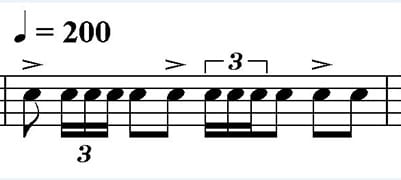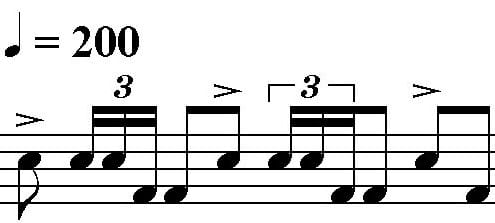Want to take your drumming to the next level? Learn how to write drum fills. Here, Chicago, IL drum instructor Michael P. shares his three simple steps to create powerful drum fills…
As a a drum teacher, I hear a lot of questions about drum fills.
Drum fills are great additions to spice up a song and show off your chops, but when you sit down to write a fill, it’s easy to end up scratching your head and asking yourself, “what do I do now?”
So next time you find yourself in this situation, try these three steps to turn a simple idea into a killer drum fill.
What Are Fills in Drumming?
If you’re a drummer, knowing how to play and create drum fills is essential because they:
- Are an essential part of drumming
- Can easily be mastered with some practice
- Fill a gap between musical phrases
- Provide a short or improvisational transition between various parts of a song
- Can serve as miniature drum solos
Of course, it’s not just drum fills that you’ll need to master as you learn to play the drums. You also need to get the hang of basic drum rudiments. Here are some of the basics:
How Do You Play Basic Drum Fills?
To create your own interesting drum fills, follow these basic tips for creating drum beats and fills.
Step 1: Research
The first step in putting together a great fill is to dig for ideas. These days, it’s easier than ever. Just Google “cool drum pattern,” “drum rudiments,” or “accent patterns,” or check out one of the many drum lessons on YouTube.
Another great strategy is to listen to drummers who play your favorite styles. See what elements they use in their fills, and try to use similar elements in your own songs.
Don’t just consider rhythm; think about the wide range of dynamics and timbres available on your drum set.
Here are some elements I like to use in my fills:
- Rhythm: eighth notes, sixteenth notes, triplets, flams, five-stroke rolls
- Dynamics: accent patterns, ghost notes
- Timbre: double-kick, tom-tom, ride bell, open hi-hat
If you want to get creative, listen to different music styles and see if you can incorporate these different drum fills patterns and techniques into your own style. Remember, the goal of a drum fill is to complement the rest of the music, so try to choose elements that will fit with your song.
Here’s an example:
My fill is a one-measure chorus-to-verse transition in a driving metal song, but I’ve decided to start simple with this classic accent pattern:
I’ll also add in triplets, double kick, and tom-toms for extra flavor.
When creating drum fills, I find it helpful to look at other drum fills samples, like these, to get an idea of what other drummers are doing.
Step 2: Deliberate Experimentation
Now that you have elements to put in your fill, it’s time for the fun part: experimenting!
Start by creating easy drum fills. At an easy tempo, play through the beat just before the fill. Once you have a good feel for that part of the song, try out a fill. Piece together some elements you like, play through them, and see how they sound together.
Then, ask yourself the following questions:
- Is there a different rhythm I could use to spice this up (flam, triplet, etc.)?
- Can I switch this note or group of notes to different instruments?
- Could I alter the volume or accent the notes in a different way?
I call this step deliberate experimentation because I use these questions systematically to transform the fill into something I really like, as in the following example:
I’ve already got some good accents here, but I want to make the unaccented rhythms more interesting, so I’ll add triplets (rhythm).
Much better, but now the fill is a bit monotonous because it’s only played on the snare drum.
I’m going to throw in some double kick (timbre).
Great. Now, let’s bring out the accents even more by doubling them up on the floor tom as well (dynamics).
I still think there’s a bit too much snare, so let’s put the unaccented snare hits on the medium tom-tom instead (timbre).
There. That’s a pretty awesome fill. See how I changed one or two elements each time to transform the ordinary accent pattern into something cool?
Step 3: Testing
Now that you have a cool fill, it’s time to test it out.
Play the fill in the context of the song. Does it match the energy and the timing? Does it complement the other instruments? Is it carrying through an important transition?
If you’re in a musical group, this is a good time to ask for feedback. Your fellow musicians will be able to tell you if you’re suffering from ODS (Overactive Drummer Syndrome).
If the fill doesn’t fit with the music, that’s OK. You aren’t always going to get it right the first time. Write down your idea and go have some more fun experimenting!
Here’s a sample of my drum fill:
I’m pretty pleased with how it sounds, so I’m going to keep it and start working on the next one.
10 Drum Fills Every Drummer Should Know
Here are some beginner drum fills that you should master if you are interested in taking your playing to the next level. They should give you some inspiration as you learn how to add your own drum fills to songs.
1. Single Note Drum Fills
These are some of the most basic drum fills – you can play them just by striking the downbeat of a measure and letting the silence do the talking for you!
2. Sixteenth Note Drum Fills
Sixteenth notes are some of the most iconic drum fills as you move from one tom-tom to another. They were popularized during the surf rock days so if you listen to a few of those songs, you should get an idea for how they’re meant to be played.
3. Eight-Note Triplets
These drum fills are ideal for songs with a steady eighth-note pulse. Also known as the “Bonham triplet,” they add a ton of energy and interest to a song.
4. Eight-Note Build
The eight-note build is a drum fill with steady eighth notes for an entire measure, letting you add more drums and more volume as the measure progresses.
5. Flam Drum Fills
A flam is an essential drum rudiment in which the drummer strikes a grace note right before the primary main stroke. This can be challenging to master but can add a ton of forward momentum to a song.
6. RLR Drum Fills
In this technique, you’ll have two 16th notes followed by an 8th note in a sticking pattern called RLR. It’s counted as ‘1-e-&, 2-e-&, 3-e-&-a, 4’
7. RRL Fills
This technique has a sticking pattern of RRL with the 1-&-a. It has a single 8th note then two 16rth notes, with two 8th notes played on the rack tom with four 16th notes on the floor tom, then two 8th notes played with the right hand on the rack tom and the left hand on snare. It’s great for adding a feeling of separation to a song!
8. Drum Fills for Adding Tension
If you want to add a bit of tension to your songs, this drum fill is simple, popular, and highly effective. Just drop out on count 1 with a loud floor tom, kick, and sanre all playing together, then come back on the first beat of the next bar.
9. Crash Cymbal and Bass Drum
With a crash cymbal and bass drum on beat 1, this song adds a lot of power to the beginning of a song. You’ll then add four 16th notes on your snare drum, two 8th notes on the rack tom, and four more 16th notes with the first hit on the floor tom with your right hand and the rest on the snare drum.
10. Crescendo Drum Fills
One of the most popular drum fills for experienced drummers it consists of straight 8th notes played on the snare and floor together. You’ll increase the volume as the bar progresses, letting you add a cool dynamic to the music. If you want, you can even add bass drums in on some quarter notes to make this drum fill even more impressive.
Tips for Playing and Creating Drum Fills
If you’re going to write your own drum fills, I have a few simple tips for you.
First, listen to all different styles of music. This will give you an idea of all the different types of interesting drum fills that are out there so you don’t find yourself stuck in a rut.
Also, don’t take it too fast. If you’re having trouble moving around the kit while you play the rhythms, simply start off by just playing the sticking pattern on the snare drum as you get used to the rhythm. You can move on to the toms later on.
Work up slowly and build your speed in increments – don’t rush into playing or writing these drum fills. You’ll just sound sloppy, forced, and inconsistent.
Finally, invest in a good metronome! Using a metronome will help you stay in time and to count – and it will also help you build up your speed as you practice.
Is There a Purpose of Adding a Drum Fill?
Drum fills serve many benefits in a song – which is why it’s so important to know how to create beautiful and powerful ones. They offer an excellent way to transition between different sections or emotions in a song while also keeping the motion of the music moving forward.
Where do you put drum fills?
Drum fills often occur at the end of a defined section or musical phrase of a song, like moving from a verse into a chorus. Because of this, knowing how to add them is essential not only if you’re a drummer, but if you plan on doing any songwriting at all.
Well, that’s it! Now you know the secret to making awesome drum fills: research, experimentation, and testing.
Go ahead and give this process a try; before long, you’ll be rocking the house like your favorite drummers!
 Post Author: Michael P.
Post Author: Michael P.Michael P. teaches percussion and drum lessons in Chicago, IL. He has been playing drums for over 15 years, and recently played with the heavy metal band Erlang Kovata. Learn more about Michael here!
Photo by Flavio Serpa
Maile Proctor











